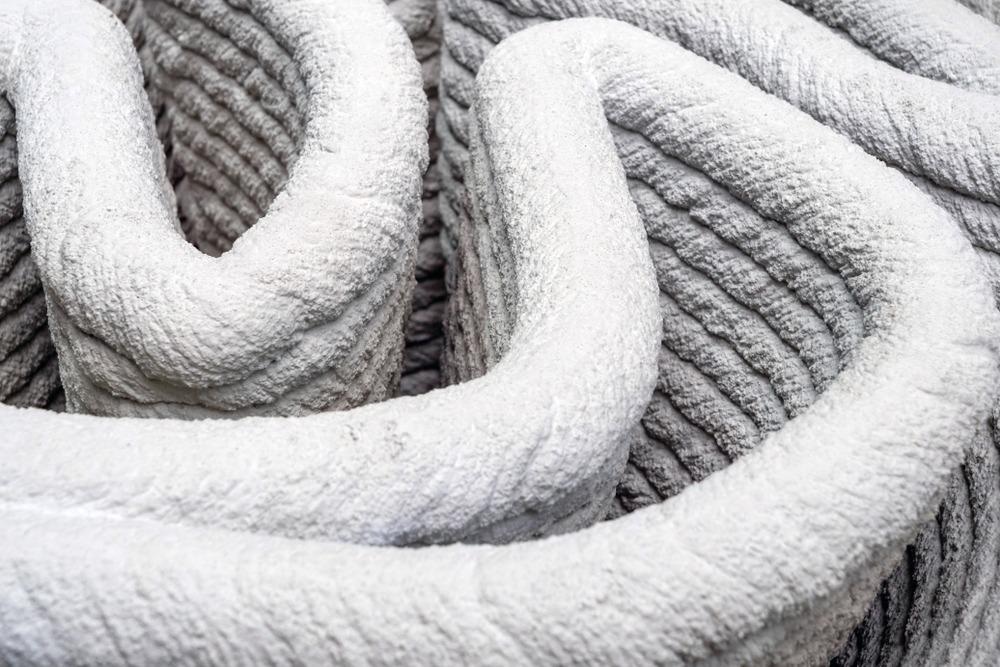The vast amounts of industrial waste generated by the construction industry present an opportunity to valorize materials for use in new building projects, improving the sustainability of the sector. A new study in the Journal of Cleaner Production has provided a comprehensive review of 3D printing concrete from industrial waste.

Study: Use of industrial waste materials for 3D printing of sustainable concrete: A review. Image Credit: Zapp2Photo/Shutterstock.com
Utilizing waste streams and turning them into commercially viable products is a central element of the circular economy concept.
Conventional Concrete Production: An Unsustainable Practice
The construction industry needs to build 10-30 million new houses every year, along with meeting infrastructure demands such as power stations, transport hubs, tunnels, and dams, to meet the needs of a rapidly growing world population, increased industrialization, and urbanization.
The most widely used material in construction, concrete, consumes huge amounts of natural resources and its manufacture is responsible for approximately 8-9% of all global greenhouse gas emissions. Moreover, conventional construction practices and demolition produce vast quantities of industrial waste, which has severe consequences for the environment.
Construction waste is predicted to reach 2.2 billion tons by 2025. When sent to landfills, heavy metals and toxins can leach into the local environment, causing contamination of ecosystems.
Clearly, if the construction industry follows a “business-as-usual” model, it will continue to cause environmental damage, generate vast quantities of waste, and emit climate-change-inducing greenhouse gases. The global construction sector has committed to reducing carbon emissions to net-zero by 2050, in line with international agreements. This has facilitated research into alternative construction methods and sustainable cementitious materials.
Sustainable Cementitious Materials
Research into sustainable cementitious mixtures has been a key focus within the construction industry and materials sciences. These mixtures typically include industrial wastes such as aluminosilicate materials that have been recovered from previous construction and infrastructure projects. Aside from improved sustainability, sustainable cementitious materials can improve the characteristics of concrete, such as its rheological properties, durability, and long-term strength.
However, traditional concrete manufacturing methods still rely heavily on fossil fuels and themselves produce waste materials, so even if a proportion of cementitious material in ordinary concrete was replaced with sustainable additives, it is not a satisfactory alternative. To overcome issues with traditional manufacturing, additive manufacturing, otherwise known as 3D printing, has been widely proposed for large-scale implementation in the global construction industry.
The Study
The new study published in the Journal of Cleaner Production has investigated the manufacture of concrete with sustainable cementitious materials and mixtures from industrial waste using 3D printing. The use of industrial waste materials confers significant advantages for 3D printing concrete due to their positive rheological properties and early age effects required for printing, and reductions in waste disposal.
The idea of 3D printing for the construction industry was first proposed in 2004, with a key development in 2011 by researchers at Loughborough University in the UK who developed 3D concrete printing. The process developed at Loughborough involves printing concrete layer-by-layer following a digital design. In the past few years, several projects worldwide have utilized this technology.
3D printed concrete must have two seemingly contradictive properties: low viscosity (extrudability) and high yield stress (buildability.) This sets them apart from conventional concrete. Due to this, the strategic use of sustainable cementitious materials and chemical admixtures must be carefully considered when designing the mixture. Several studies have focused on the use of these materials as admixtures in Ordinary Portland cement.
Advances in waste management have been integral to the development of sustainable 3D printed materials with tunable rheology and early-age response. The study has discussed the use of sustainable cementitious materials and other industrial wastes in 3D concrete printing. Additionally, the economic and environmental impact of the technology has been considered in the study to provide a perspective on its sustainability.
Industrial wastes suitable for sustainable cementitious materials investigated by the authors include fly ash, silica fume, blast furnace slag waste, limestone, quartz, mine tailings, and biomass ashes. Factors that control the use of these materials for sustainable printable cementitious materials highlighted include cost and availability and their effects on the finished product. Other considerations include process optimization of 3D printing.
The authors have provided a comprehensive literature review, considering papers from multiple sources published up to July 2021. 1000 documents were narrowed down and non-relevant papers were removed from the study. The study’s key novel contribution to the field is a comprehensive and critical analysis of industrial wastes which can are suitable for 3D printing and cleaner production.
Finally, the authors have identified future perspectives and opportunities which will govern the commercial viability of 3D printed sustainable cementitious materials derived from industrial waste. The authors have stated that the paper is potentially useful for both industry and academia, and could serve as a reference document for policymakers and assist in the long-term attainment of the UN Sustainable Development Goals’ targets.
Further Reading
Dey, D et al. (2022) Use of industrial waste materials for 3D printing of sustainable concrete: A review [online] Journal of Cleaner Production 340 130749 | sciencedirect.com. Available at: https://www.sciencedirect.com/science/article/pii/S0959652622003882
Disclaimer: The views expressed here are those of the author expressed in their private capacity and do not necessarily represent the views of AZoM.com Limited T/A AZoNetwork the owner and operator of this website. This disclaimer forms part of the Terms and conditions of use of this website.